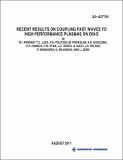| dc.contributor.author | Porkolab, Miklos | |
| dc.contributor.author | Pinsker, R. I. | |
| dc.contributor.author | Luce, T. C. | |
| dc.contributor.author | Politzer, P. A. | |
| dc.contributor.author | Goulding, R. H. | |
| dc.contributor.author | Hanson, G. R. | |
| dc.contributor.author | Ryan, P. M. | |
| dc.contributor.author | Hosea, J. C. | |
| dc.contributor.author | Nagy, A. | |
| dc.contributor.author | Wilson, J. R. | |
| dc.contributor.author | Maggiora, R. | |
| dc.contributor.author | Milanesio, D. | |
| dc.contributor.author | Zeng, L. | |
| dc.date.accessioned | 2013-01-30T19:47:30Z | |
| dc.date.available | 2013-01-30T19:47:30Z | |
| dc.date.issued | 2011-06 | |
| dc.identifier.issn | 0094-243X | |
| dc.identifier.issn | 1551-7616 | |
| dc.identifier.uri | http://hdl.handle.net/1721.1/76680 | |
| dc.description.abstract | Fast Waves (FWs) at 60 MHz and 90 MHz are used in DIII‐D for central electron heating and current drive. Coupling of FWs to high‐performance discharges is limited by low antenna loading in these regimes. To extend the application of high‐power FWs to such regimes, methods of increasing the antenna loading in these regimes are needed. A systematic study of loading enhancement techniques has been carried out in DIII‐D, including reduction of the antenna∕plasma distance, gas puffing into the far scrape‐off layer (SOL), and control of other parameters that affect the particle balance in the far SOL. Quantitative understanding of the physics of the loading resistance and its dependence on edge density profiles is demonstrated. The core FW heating efficiency appeared to be ∼100% in the Advanced Inductive regime, consistent with the high first‐pass direct electron absorption of ∼75% that is predicted by the ray‐tracing code GENRAY in this high electron beta regime. | en_US |
| dc.description.sponsorship | United States. Dept. of Energy (Grant DE-FC02-04ER54698) | en_US |
| dc.description.sponsorship | United States. Dept. of Energy (Grant DE-FG02-940ER54084) | en_US |
| dc.description.sponsorship | United States. Dept. of Energy (Grant DE-AC05-00OR22725) | en_US |
| dc.description.sponsorship | United States. Dept. of Energy (Grant DE-AC02-09CH11466) | en_US |
| dc.description.sponsorship | United States. Dept. of Energy (Grant DE-FG02-08ER54984) | en_US |
| dc.language.iso | en_US | |
| dc.publisher | American Institute of Physics (AIP) | en_US |
| dc.relation.isversionof | http://dx.doi.org/10.1063/1.3664983 | en_US |
| dc.rights | Creative Commons Attribution-Noncommercial-Share Alike 3.0 | en_US |
| dc.rights.uri | http://creativecommons.org/licenses/by-nc-sa/3.0/ | en_US |
| dc.source | General Atomics | en_US |
| dc.title | Recent Results on Coupling Fast Waves to High Performance Plasmas on DIII-D | en_US |
| dc.type | Article | en_US |
| dc.identifier.citation | Pinsker, R. I. et al. “Recent Results on Coupling Fast Waves to High Performance Plasmas on DIII-D.” AIP Conference Proceedings 1406 (2011): 313–320. | en_US |
| dc.contributor.department | Massachusetts Institute of Technology. Plasma Science and Fusion Center | en_US |
| dc.contributor.mitauthor | Porkolab, Miklos | |
| dc.relation.journal | AIP Conference Proceedings | en_US |
| dc.eprint.version | Author's final manuscript | en_US |
| dc.type.uri | http://purl.org/eprint/type/ConferencePaper | en_US |
| dspace.orderedauthors | Pinsker, R. I.; Luce, T. C.; Politzer, P. A.; Porkolab, M.; Goulding, R. H.; Hanson, G. R.; Ryan, P. M.; Hosea, J. C.; Nagy, A.; Wilson, J. R.; Maggiora, R.; Milanesio, D.; Zeng, L.; Phillips, Cynthia K.; Wilson, James R. | en |
| dc.identifier.orcid | https://orcid.org/0000-0002-9518-4097 | |
| mit.license | OPEN_ACCESS_POLICY | en_US |
| mit.metadata.status | Complete | |
